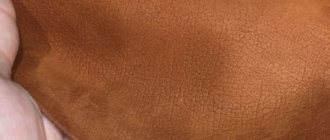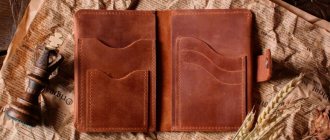Not so long ago, shoes and furniture made of velvety material reminiscent of suede appeared in stores. Nubuck - that’s the name of this substance - is presented in natural and artificial forms. Buyers are advised to learn more about this material in advance: how to care for it, how to use it, the differences between originals and fakes, and physical properties.
Features of nubuck
Nubuck gets its name from a special method of processing animal leather. Typically, cattle hides are used to make it. To prevent them from losing their appearance, the inner surface is treated with a special compound. Nubuck products come in several types:
- natural;
- artificial;
- oil.
This material is little known to consumers, as it appeared in stores relatively recently. But it is used to make shoes and bags. The material is distinguished by its durability, practicality, and high resistance to moisture. Nubuck, made specifically for sewing sneakers, boots and shoes, has these properties. If leather is necessary for finishing furniture, then it is given wear resistance, strength, and water-repellent characteristics.
Does artificial or natural nubuck get wet?
Natural nubuck can get wet
Nubuck is a durable material, especially if it is natural. But, alas, it is not without its shortcomings. Shoes made from this leather tend to allow water to pass through. And although this takes a lot of time, wearing nubuck boots for a long time in conditions of high humidity outside leads to the product getting wet.
Worth knowing: If you do not completely dry a wet natural nubuck product, creases will begin to appear on its surface. Therefore, always use newsprint or a special device to dry your boots from the inside.
As for artificial nubuck, it is more durable and hardy. Because its surface is harder than natural material, it repels water much more effectively. Therefore, there is less fear of such a product getting wet.
If your shoes do get wet, then read the article on our website about how to quickly dry boots made of leather, suede or nubuck .
However, in both cases, other nuances are possible:
- It is important to monitor the integrity of the soles of your boots, as they can peel off over time.
- Water “enters” faster into the resulting cracks.
- Therefore, your feet may also be wet after wearing shoes.
To avoid this, experts recommend taking special preventative measures. It is carried out in specialized shoe repair shops. In addition, preventive measures add durability to shoes and reduce their wear, so it is advisable not to spare money on their implementation. It costs much less than buying new leather boots. Good luck!
Natural and artificial material
The high cost of natural nubuck is due to the costs of its production and processing. For its production, the skin of cattle - cows and bulls - is used. By itself it is rough and hard. It is treated with mineral salts and fine sea sand. After this procedure, the material becomes soft and pleasant to the touch. The tanned leather is breathable and has a small pile.
It is often used in the production and finishing of furniture. Italian factories were able to appreciate the tactile and physical properties of natural nubuck, so furniture made from it is very high quality, but expensive.
Advantages and disadvantages
Advantages of nubuck: durability, pleasant appearance, breathability. Things made from it always look stylish and expensive and complement any outfit.
Disadvantages: delicacy. Afraid of wet weather, requires careful care. The purchase of related care products is required on a regular basis, which is not financially profitable.
Advantages and disadvantages of shoes
Women prefer to purchase nubuck shoes because of its positive characteristics. These include pleasant tactile qualities and durability. Nubuck is a beautiful material that looks like suede. Products made from it look very expensive and elegant. The shoes are suitable for special occasions and the office.
But there are also significant drawbacks due to which some buyers refuse this material. These include:
- additional expenses for care;
- loss of attractive appearance;
- difficult cleaning;
- mandatory regular processing.
Shoes need to be cleaned with special brushes. Do not use metal products, do not get your shoes wet. It takes a lot of time to care.
This is especially true for shoes that have been in the rain. It quickly loses its attractive appearance and can become unstuck from moisture. Not everyone is willing to put in the effort to clean dirt and dust.
To maintain strength, you need to periodically treat nubuck with chemicals and antistatic agents. You need to be careful when buying nubuck shoes. Pros and cons play their role, but you need to be able to distinguish natural material from fake.
Compound
The process for creating faux nubuck varies. Depending on the technology, either woven or non-woven material is obtained. Most often, the method of spraying thin polymer layers on top of each other is used. In addition, finished fabrics can be subjected to additional processing - to create increased protection from moisture, for example.
And yet, we are talking about synthetics. The composition of artificial nubuck is almost 100% modern high-tech polymer, providing the material with all the necessary properties.
Today, the production of the described textiles is so developed that the end result is fabrics that are practically indistinguishable from natural ones, but at the same time more affordable and practical to use.
Differences from suede
Nubuck, leather and suede are used by designers to create different types of clothing - trousers, skirts, raincoats, jackets, hats and gloves, as well as for the production of shoes and accessories. But the materials differ in their characteristics.
Natural suede is made exclusively from deerskin. It is processed, tanned, after which it becomes soft. Only the skin of a young animal is used. It has short soft bristles and a delicate texture. Nubuck is made from buffalo, cow or ox leather. For small items - gloves, key rings, bookmarks - the skin of small calves is used.
Suede is tanned using oils and fats. This is how masters achieve softness and elasticity. Nubuck is treated with chrome plating using fine salt and sand. As a result of this procedure, the material becomes soft, but quickly begins to get wet and gets dirty easily. Nubuck has a fairly short pile, while suede has a longer pile.
Suede is more suitable for long-term use. It is more resistant to moisture and dirt. Natural nubuck quickly absorbs water and dust, is less easy to clean and loses its attractiveness in a shorter time.
Disadvantages of nubuck shoes
Unfortunately, in addition to all the advantages, there are also its disadvantages. First of all, nubuck itself, as a material, does not tolerate moisture at all . Therefore, walking in it on lawns or on a rainy day would not be the best idea. Because as a result, recently purchased shoes or boots will quickly lose their original appeal.
Flaws:
- nubuck can rub your feet, creating discomfort;
- does not tolerate aggressive external environments (water, dirt, frost);
- no stronger than leather.
Rules of care
Things made from this material are classified as capricious and expensive goods, so not everyone decides to buy them. According to modern trends, winter and summer shoes are made from it. Recently, sneakers, sports boots and sandals have become fashionable. For everyday use, such products will be impractical, but with proper care you can extend their service life.
The first rule of good handling of nubuck is not to wear shoes made from it outside in rain or wet weather. The material is intended only for dry climates, indoors and warm air. When purchasing products, you will have to spend money on additional goods. For maintenance you will need the following tools:
- brush for cleaning dirt;
- paint for the material to match the shoes;
- nanospray;
- drying liners.
It is necessary to treat the surface of the product, dry it and brush it again. The last layer should be the application of a protective agent. It will create a barrier that prevents the absorption of moisture, reagents and dust. Prevention will protect the material from rapid contamination.
In winter, it is easier to care for shoes, since there is no dust and liquid dirt. But the snow in cities is never clean, so you still have to clean the nubuck. You can wipe the surface of the products with flannel and dry them from moisture. If your shoes are wet through and through, you cannot immediately clean off the dirt from them. It is necessary to stuff the shoes with crumpled paper or newspapers to dry them completely. You can also use canvas bags with rice or sea salt for this. These substances quickly absorb moisture. They also recommend using electric earbuds, but you should not turn them on at full power.
It is more difficult to care for summer shoes made of nubuck. Even a few minutes on a dusty street can destroy all the elegance of shoes or sandals. To remove dirty deposits, you need to use a special suede brush or sponge. After a walk, you can apply cleaning foam, and any stains can be easily dealt with with a regular office eraser. Once they rub the dirt, it will easily come off and the pile will rise. As a result, the product will take on a fresher look.
Shiny spots occur due to the fact that the fibers roll off. Excess shine is removed with cotton pads soaked in ammonia.
The skin is lifted with a special brush or sponge. To completely renew the product, they give it a steam bath. Water is boiled in a large container, as soon as steam appears, a pair of shoes is held over it. Then the material is wiped with a flannel cloth.
Storage
Finally, a few storage tips:
- Before putting your shoes in the closet, you should thoroughly clean and dry them at room temperature, and remove the insoles.
- To prevent microorganisms from multiplying in natural nubuck boots during storage, they should be treated with a disinfectant (Chlorkegsidin, Miramistin).
- Place the boots in a spacious box with holes for ventilation; if there are none, make your own.
- Do not place shoes in plastic bags; they may become damaged or become moldy.
Product reviews
Natural nubuck will never lose its popularity. After all, it looks expensive and elegant, suitable for any style. By constantly following the rules of care and handling the products carefully, you can wear shoes for years without losing their original appearance. Such a wardrobe item will emphasize style and good taste.
I really love suede shoes, but they are so expensive. I recently found a good replacement: nubuck boots. They look almost the same, very beautiful. They are difficult to care for, but the elegant look is worth it.
Agata, 32 years old
I have been working in an office almost since graduating from college. I already hold a decent position, so I should look appropriate. I love quality shoes, I prefer nubuck. It does not get dirty indoors and looks very expensive and solid.
Maxim, 47 years old
I often buy different things made of nubuck: shoes, bags, gloves and hats. I love it for its strength and softness. I especially like to combine items of the same shade in one look. The material is great for spring and autumn.
Daria, 22 years old
How do you like the article?
Application area
As has been mentioned more than once above, the main use of artificial nubuck is the production of shoes. Today there are many models made from this textile material. Moreover, modern manufacturers offer different types of shoes: boots, sneakers, ankle boots, boots, even elegant shoes. The products are distinguished by their stylish design, variety of colors, and beauty.
However, the material described is not only used for shoes. It is used to make original bags and bright accessories. Craftswomen use artificial nubuck in their own crafts. It is used to create home textiles, cute toys, authentic panels, etc.
The material is often used for upholstery of furniture: sofas, armchairs, chairs, etc. In the interior it looks elegant, ideal for today's popular styles: minimalism, eco, modern.
How to avoid damaging your shoes
The seller should tell you whether nubuck can be washed under water, but it is still not advisable to wet or clean wet products. The material is deformed and loses its properties, so it must be thoroughly dried before processing. Do not use creams or aerosols intended for smooth skin. Moreover, you cannot wash products in soapy water or hair shampoo. The foam is difficult to wash out, which is why stains remain and the structure of nubuck deteriorates.
It is recommended to store shoes or boots in fabric bags or boxes; plastic bags are not suitable. Before you put them away for the summer or winter, you should clean them, removing all dirt.
Any shoes require regular treatment, but caring for nubuck shoes includes several stages. These include cleaning the product with brushes or shampoos, applying protective liquids, and even painting.
What to wear with
Nubuck boots are sewn using the same principles as other leather shoes. Although modern couturiers are actively experimenting with eclecticism, there are generally accepted standards for what and how to wear shoes of a particular style. Sports boots go well with jeans and pants, but you shouldn’t always wear them with a skirt or dress. Bold sets look original on teenagers, since the urban style of teenagers allows for a casual look. In adulthood, you will have to more carefully select clothes that match your shoes in style:
- Mini, midi, maxi skirts of various cuts are perfect for boots with heels. Sets with a shirt and a classic coat will organically fit into the office style.
- Low-heeled shoes can be complemented with skinny jeans, a T-shirt, a thick knit cardigan, a leather jacket or a parka.
- A hoodie dress or sports model, as well as a unisex coat, go well with casual walking boots. It is worth remembering that shoes that are too massive can ruin and make your look heavier.
Men's fashion is more universal, but also conservative at the same time. Dress boots should not be worn with sweatpants, and tall models are not suitable for a business suit. A certain compromise can be achieved by wearing a fitted jacket, classic jeans in combination with lace-up nubuck boots. This style is quite acceptable in the office.
Types of boots
Because nubuck has proven itself so well, manufacturers have begun to use it for a wide variety of shoe styles. Depending on the time of year and style, the density of the material, the degree of insulation of the product, the height and shape of the sole vary.
By season
Insulated winter boots made of nubuck are the best choice for dry, frosty days. They are distinguished by a rather high sole, but a relatively low heel, since the shoes must be stable and not slip in icy conditions. A fur lining must be present. It is better that it be natural, since the faux fur liner quickly loses its heat-protective properties and gets knocked down. Faux nubuck boots can also have a natural lining. If they are to be worn in a region where winter temperatures often drop below -10 °C, such insulation is a must, otherwise there is a risk of frostbite.
Nowadays, a variety of winter shoes made of nubuck are in fashion: from classic versions with a zipper to sporty chukka models with laces. Spring-autumn nubuck boots are a lightweight option suitable for warmer weather. For such models, a faux fur lining is quite suitable if the spring or autumn temperature does not drop below -5 ˚С.
Restoring nubuck boots after they have been exposed to rain is a tedious task, so it is best to wear such shoes in dry weather. If the region has a lot of rainfall, you should pay attention to a combined combination of materials, where the toe and back are made of waterproof raw materials. The quality of tailoring also matters.
In any shoe, it is most often not the material itself that allows moisture to pass through, but the seams and joints between the upper and the sole. Stitched winter boots are considered the most reliable.
Winter
Demi-season
By type of sole and heel
The sole is also of no small importance, since the safety of the upper part of the shoe directly depends on its quality. If you walk through snowdrifts in winter in low-heeled boots, then, most likely, the tops will get wet, since light weight snow tends to get on socks with heels. Therefore, high soles are not only a fashion trend, but also a mandatory attribute of nubuck winter boots.
In general, products are classified according to the following types of soles:
- at low speed - usually used for making light autumn-spring shoes;
- Winter and road models are made on tractor soles, as they do not slip;
- Women's autumn boots and closed shoes made of nubuck are produced with high heels;
- low heels are usually found in lightweight men's shoes and loafers;
- on the platform there can be either light shoes or nubuck boots, depending on the style.
You should study in advance how to care for nubuck shoes so that they last longer and maintain their appearance.
At low speed
With tractor sole and low heel
High heels
On the platform











